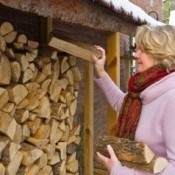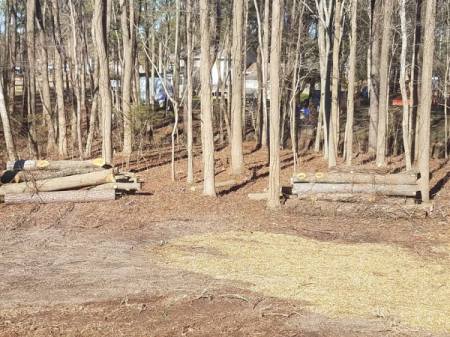 When the weather turns cold, fireplaces and wood burning stoves are a great way to provide our homes with an additional source of heat and a warm and cozy atmosphere. Before you buy your supply firewood for the upcoming season, here are a few things to consider.
When the weather turns cold, fireplaces and wood burning stoves are a great way to provide our homes with an additional source of heat and a warm and cozy atmosphere. Before you buy your supply firewood for the upcoming season, here are a few things to consider.
Buy Local
Buying firewood from a reputable local source promotes good forestry. Moving firewood long distances can introduce harmful insects and diseases that can weaken and kill local trees (e.g. emerald ash borers, gypsy moths, Dutch elm disease, and Oak wilt).
Plan Ahead
Spring is a great time to buy firewood. If you're willing to buy "green" wood and store it yourself until it's fully dry, you may be able to cut the cost by as much as 30%. Also, if you wait until fall to buy firewood you run the risk of having to settle (and pay) for whatever the dealer has available.
Look for the Species of Wood
Not all types of wood burn equally. It all comes down to density. Denser wood burns more slowly and has a higher heating value. In general, hardwoods (wood from leaf-bearing trees) are generally denser and can have up to twice as much heat value per cord as softwoods (wood from needle-bearing trees). Softwoods are typically easier to split, and although they may burn hot, they also generally burn a lot faster.
Know Exactly What You're Paying For
The price of firewood is generally based on the following factors:
Note: Not all species split equally as well either. This is worth knowing if you plan to split the wood yourself to save some money. Denser wood is generally harder to split. Oak, for example, has a high heating value and makes a very good firewood, but it can be difficult to split. Pine has a low heating value (burns hot, but very fast), and is easy to split.
Avoid storing wood next to the house (or other buildings)
Wood piles are havens for insects, but there's no need to turn your house into one. Store your firewood in a location that is convenient for bringing it indoors, but one that is far enough away from buildings to keep insects outside.
Keep firewood elevated
Wood touching the ground will quickly start to decompose. Keep your pile several inches off the ground by stacking the bottom rows on wood pallets or 2x 4s.
Keep air circulating
If you're stacking multiple cords, leave at least 6 inches of air space between them to allow for maximum drying.
Bring in a little at a time
A large plastic storage bin with a lid provides a nice transition (and insect buffer) from the woodpile to indoors. You can buy them in sizes as large as 45 gallons - the perfect size for storing a week's worth of firewood in the garage or under the basement stairs. When full of wood these bins get heavy, so look for styles with wheels and get help when moving it. Keep the lid on to keep traveling insects inside the bin and keep your children and pets safely out.
Before the onset of chilly weather, have your wood burning stove or fireplace cleaned and inspected to make sure everything is in proper working order.
Burn "seasoned" wood
"Seasoned" (dry) firewood, is wood that has been cut and air dried for at least 6 months prior to being burned. Seasoned firewood has a lower moisture content than green firewood, so it ignites easier, burns cleaner, and delivers heat more efficiently than green wood. It also smolders less and deposits less creosote on your chimney. To determine whether or not the wood you're burning is seasoned, look for the following signs:
Don't overload your firebox.
A large, hot fire might seem like it will heat your house better, but it won't. You'll only end up wasting wood, and possible cause dangerous cracks to form in your chimney tiles that can lead to a house fire. Never burn garbage, large amounts of paper, or construction debris. They can produce toxic fumes, and leave dangerous deposits on your chimney.
Burn smart
Good fireplace habits can decrease your home's fuel consumption while maintaining a comfortable level of warmth. Make sure your firewood gets enough air to burn properly. Always use a fire screen, and close the damper when the fire is out to keep warm air from escaping up your chimney.
This page contains the following solutions.
We managed to get nearly all of our wood this year from local building sites. The builders are only too happy to empty their expensive skips of offcuts and waste wood. So, if you have a van and time next year start early.
For all of us living in areas that get lots of snow we are stocking up now on firewood. Whether you cut it up yourself or have some one else cut and deliver it to you, here are some tips you need to know.
Frugal tips or ideas for getting firewood as suggested from the ThriftyFun community. You can cut wood in most Federal or State forests by paying a small permit fee. Advertise in the paper for free firewood needs. Offer to cut down logs on someone's property for the wood.
I heat with wood. At first getting it delivered to my home, which is 12 miles from town on a mountain, was expensive. This winter, I queried neighbors and found 2 guys on my mountain that are much cheaper.
You can save money on firewood by getting it in early summer and late spring. For starters, you pay a premium the closer you get to cold weather. And, you don't have to limit yourself to buying firewood that is completely dry, it will cure over the summer months and be ready to burn when you need it.
I always order my firewood delivery as early in the season as possible, that ensures the best prices before wood becomes scarce. I shop around for the best price, make sure that the wood is split to the length I need.
Here are the questions asked by community members. Read on to see the answers provided by the ThriftyFun community.
I live in Virginia Beach, Virginia. I recently cut down 10+ large trees that were over 50 feet tall. They are a mix of pine and gumball trees. I got a local tree service to cut them down. I felt they'd sell them to a local lumber yard, so I refused to have them haul them away. I looking for someone who will cut and split it into firewood for free.
In return I would allow them to take an equal share. For instance, if they cut and split a 16 foot section, then they can take just that, a 16 foot portion. Can you recommend a reliable source in my area that would do these services? Thank you!
If you post an ad in Craigslist I'm sure you will find takers. People are always looking for a way to make extra cash.
aer there any of your friends that burn wood? they would be a good person to do the work OR they might know a good recommendations...